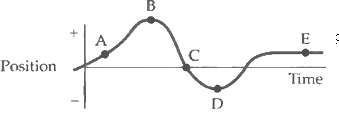(Multiple Choice) (1) The diagram in Figure tracks the path of an object moving in a straight...
Question:
(Multiple Choice)
(1)
The diagram in Figure tracks the path of an object moving in a straight line. At which point is the object farthest from its starting point?
(a) A
(b) B
(c) C
(d) D
(e) E

(2)
An object moves along the x axis as shown in Figure. At which point or points is the magnitude of its velocity at a minimum?
(a) A and E
(b) B, D, and E
(c) C only
(d) E only
(e) None of these is correct.

(3) True / False
(a) If the acceleration is zero, the body cannot be moving.
(b) If the acceleration is zero, the x-versus-t curve must be straight line.
(4)
An object thrown straight up falls back to the ground T seconds later. Its maximum height is H meters. Its average velocity during those T seconds is
(a) H/T,
(b) 0,
(c) H/2T,
(d) 2H/T.
(5)
For an object thrown straight up, which of the following is true while it is in the air? (a) The acceleration is always opposite to the velocity.
(b) The acceleration is always directed downward.
(c) The acceleration is always in the direction of motion.
(d) The acceleration is zero at the top of the trajectory.
(6)
An object projected up with initial velocity v attains a height H. Another object projected up with initial velocity 2v will attain a height of
(a) 4H,
(b) 3H,
(c) 2H,
(d) H.
(7)
A ball is thrown upward. While it is in the air, its acceleration is
(a) Decreasing,
(b) Constant,
(c) Zero,
(d) Increasing.
Step by Step Answer:

Fundamentals of Ethics for Scientists and Engineers
ISBN: 978-0195134889
1st Edition
Authors: Edmund G. Seebauer, Robert L. Barry





